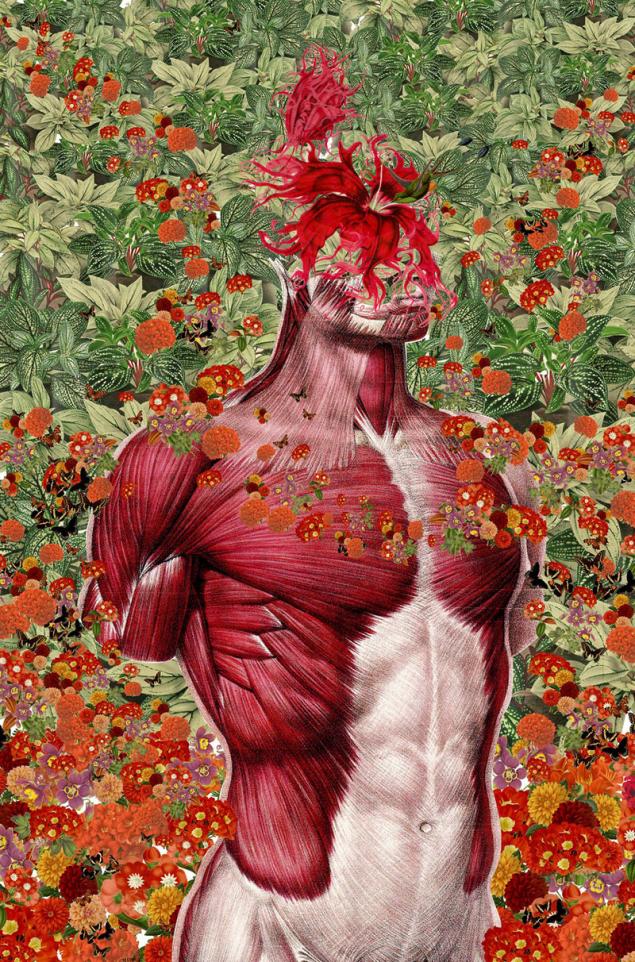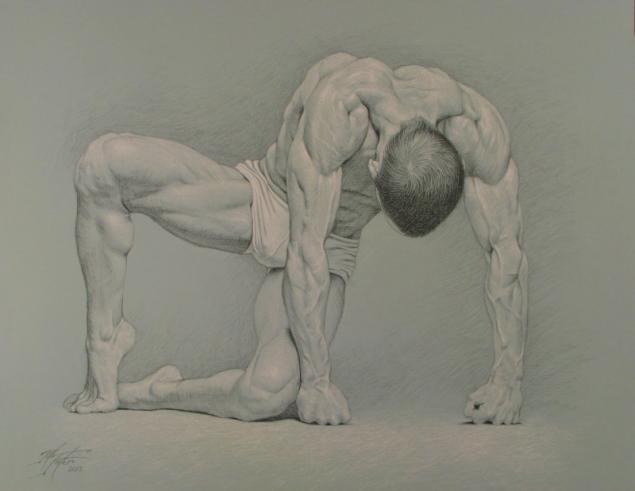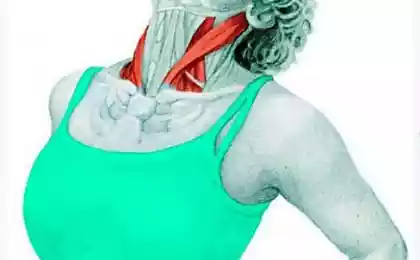521
10 most interesting facts about muscles
The 200 muscles involved in only one step. The heart is the most resilient muscle of the body — permanently. Muscles are grown and trained, they are written tons of sports literature. We will tell you the most interesting.

1. How many muscles?
Only in the human body count from 640 to 850 muscles. During a simple walk, the body uses up to 200 muscles. Muscle tissue is 15% denser and heavier than fat, so a trained person can exceed in weight full, but received a man the same height. Muscle accounts for up to 40% of body weight.
2. The best muscle
The hardy muscle of the human heart, the short — stremennaya (it strains the tympanic membrane in the ear). Its length is 1.27 mm. The longest muscle of the human body is the Sartorius. The fastest muscle — pulsing. About what muscle of the body is the most powerful, can meet different opinions. Often say that the most powerful muscle — the tongue, but the tongue consists of several muscles, so this view is false. Very strong are the muscles of mastication (the power of pressure can reach 100 kg), and calves and gluteal muscles.
3. Such different muscles
Human muscles are not the same. Therefore, to train them should be different, and the time to recover and different muscle groups different. The fastest way to recover your triceps, the slowest — back muscles. This should be considered when training, rest muscles not less than the load, because the growth of muscle fibers occurs due to the effect of supercompensation. Full muscle recovery takes place only after 48 hours after intensive exercise.
4. Muscle endurance
Endurance — ability of muscles to maintain performance over time. The hardy muscle of the human body, as we have said, is the heart. According to doctors, the "margin of safety" the average heart not less than 100 years. The muscles begin to tire, when in low glycogen, fatigue is also due to the large number of muscle calcium.
Previously, it was believed that the main culprit of fatigue is lactic acid. At Columbia University conducted a study in which mice three weeks, swam every day, and cyclists for three days training. It turned out that after exercise in chemical structure ryanodine receptor, which is responsible for muscle contraction, major changes occurred — there was a gap in the cell membrane through which calcium leaking into muscle cells.

5. Muscles and emotions
It is known that the movement of the facial muscles directly related to human emotions. Early last century Russian scientist Ivan Sikorsky made the classification of facial expressions: the muscles around the eyes are responsible for the expression of mental phenomena, the muscles around the mouth for the expression of acts of will, and I Express my feelings all the muscles of the face.
In 2011, scientists were able to discover the facial expressions of the person occurs long before his birth. During the antenatal period, the child is able to move facial muscles, smile, surprise to raise the eyebrows or frown. Facial muscles constitute 25% of the total number of muscles while smiling involved 17 groups of muscles during anger or crying — 43. One of the best ways to maintain smooth skin on my face — kissing. When they work from 29 to 34 muscle groups.
6. Muscles and genes
Amazingly, muscle training impacts not only the individual but also on his genes. In them there are modifications that can further help the muscle fibers to be ready for new loads.
In order to prove or disprove scientists from the University of Aarhus has gained a focus group of 20 volunteers and gave them a 20-minute aerobic exercise on a stationary bike. After the study subjects have been taken a biopsy of the quadriceps to see how changes in their cells genes. It turned out that physical activity activates genes related to muscles.
This is because the cells retain DNA with methyl groups. If you remove them, the gene information is converted into enzymes and proteins that are necessary for calorie burning, muscle growth and oxygen consumption. After the experiment all participants in the study, the number of methyl groups was reduced — that is the muscles adapt to increase metabolism.
7. Muscle and telepathy
A simple man is unable to establish control over all muscles of the body, so the unconscious muscle contraction may serve to the people who know an indicator of underlying thoughts or intended actions. Psychologists high level "psychic" can use knowledge about these processes. Wolf messing, one of the most famous telepaths explained his phenomenal abilities are not magic, and a thorough knowledge of the work of the human muscle. He said: "It's not mind reading, and, so to speak, "reading of muscles"... When the person tensely thinks about something, brain cells transmit impulses to all the muscles of the body."
8. Long Palmar muscle
Only one in six people on earth has survived on both hands the long Palmar muscle. For some there are only one of the hands. These muscle fibers are responsible in animals for the release of the claws. Man, of course, such a function is not needed. Long Palmar muscle, thus, are a vestige used by the surgeons in case of need as a material for the transplantation of muscles.
9. Muscles and chocolate
Oddly enough, one of the most useful products for the heart and muscles in General is dark chocolate. Studies conducted at Wayne state University in Detroit has revealed the influence contained in dark chocolate substances epicatechin on the growth of mitochondria in muscle cells.
Scientists l'aquila University conducted a study in which subjects were given one hundred grams of chocolate for 15 days and measured their blood pressure. In the experiment, people have normal pressure, improved blood circulation. Accordingly, the moderate consumption of dark chocolate can be seen as preventing heart disease and atherosclerosis.
See also: Energy code partnership
Why it is important not to think badly about anyone
10. Muscle loss
Muscle is not eternal. After 40 years, they start to actively burnt, in the year the person starts to lose 2 to 3 percent of muscle tissue, after 60 years — up to 5 %. Therefore, training in adulthood is no less important than in youth.published
P. S. And remember, only by changing their consumption — together we change the world! ©
Source: m.facebook.com/osteoukr/photos/a.1407085066097867.1073741826.1407084999431207/1445676718905368/?type=3&__tn__=E

1. How many muscles?
Only in the human body count from 640 to 850 muscles. During a simple walk, the body uses up to 200 muscles. Muscle tissue is 15% denser and heavier than fat, so a trained person can exceed in weight full, but received a man the same height. Muscle accounts for up to 40% of body weight.
2. The best muscle
The hardy muscle of the human heart, the short — stremennaya (it strains the tympanic membrane in the ear). Its length is 1.27 mm. The longest muscle of the human body is the Sartorius. The fastest muscle — pulsing. About what muscle of the body is the most powerful, can meet different opinions. Often say that the most powerful muscle — the tongue, but the tongue consists of several muscles, so this view is false. Very strong are the muscles of mastication (the power of pressure can reach 100 kg), and calves and gluteal muscles.
3. Such different muscles
Human muscles are not the same. Therefore, to train them should be different, and the time to recover and different muscle groups different. The fastest way to recover your triceps, the slowest — back muscles. This should be considered when training, rest muscles not less than the load, because the growth of muscle fibers occurs due to the effect of supercompensation. Full muscle recovery takes place only after 48 hours after intensive exercise.
4. Muscle endurance
Endurance — ability of muscles to maintain performance over time. The hardy muscle of the human body, as we have said, is the heart. According to doctors, the "margin of safety" the average heart not less than 100 years. The muscles begin to tire, when in low glycogen, fatigue is also due to the large number of muscle calcium.
Previously, it was believed that the main culprit of fatigue is lactic acid. At Columbia University conducted a study in which mice three weeks, swam every day, and cyclists for three days training. It turned out that after exercise in chemical structure ryanodine receptor, which is responsible for muscle contraction, major changes occurred — there was a gap in the cell membrane through which calcium leaking into muscle cells.

5. Muscles and emotions
It is known that the movement of the facial muscles directly related to human emotions. Early last century Russian scientist Ivan Sikorsky made the classification of facial expressions: the muscles around the eyes are responsible for the expression of mental phenomena, the muscles around the mouth for the expression of acts of will, and I Express my feelings all the muscles of the face.
In 2011, scientists were able to discover the facial expressions of the person occurs long before his birth. During the antenatal period, the child is able to move facial muscles, smile, surprise to raise the eyebrows or frown. Facial muscles constitute 25% of the total number of muscles while smiling involved 17 groups of muscles during anger or crying — 43. One of the best ways to maintain smooth skin on my face — kissing. When they work from 29 to 34 muscle groups.
6. Muscles and genes
Amazingly, muscle training impacts not only the individual but also on his genes. In them there are modifications that can further help the muscle fibers to be ready for new loads.
In order to prove or disprove scientists from the University of Aarhus has gained a focus group of 20 volunteers and gave them a 20-minute aerobic exercise on a stationary bike. After the study subjects have been taken a biopsy of the quadriceps to see how changes in their cells genes. It turned out that physical activity activates genes related to muscles.
This is because the cells retain DNA with methyl groups. If you remove them, the gene information is converted into enzymes and proteins that are necessary for calorie burning, muscle growth and oxygen consumption. After the experiment all participants in the study, the number of methyl groups was reduced — that is the muscles adapt to increase metabolism.
7. Muscle and telepathy
A simple man is unable to establish control over all muscles of the body, so the unconscious muscle contraction may serve to the people who know an indicator of underlying thoughts or intended actions. Psychologists high level "psychic" can use knowledge about these processes. Wolf messing, one of the most famous telepaths explained his phenomenal abilities are not magic, and a thorough knowledge of the work of the human muscle. He said: "It's not mind reading, and, so to speak, "reading of muscles"... When the person tensely thinks about something, brain cells transmit impulses to all the muscles of the body."
8. Long Palmar muscle
Only one in six people on earth has survived on both hands the long Palmar muscle. For some there are only one of the hands. These muscle fibers are responsible in animals for the release of the claws. Man, of course, such a function is not needed. Long Palmar muscle, thus, are a vestige used by the surgeons in case of need as a material for the transplantation of muscles.
9. Muscles and chocolate
Oddly enough, one of the most useful products for the heart and muscles in General is dark chocolate. Studies conducted at Wayne state University in Detroit has revealed the influence contained in dark chocolate substances epicatechin on the growth of mitochondria in muscle cells.
Scientists l'aquila University conducted a study in which subjects were given one hundred grams of chocolate for 15 days and measured their blood pressure. In the experiment, people have normal pressure, improved blood circulation. Accordingly, the moderate consumption of dark chocolate can be seen as preventing heart disease and atherosclerosis.
See also: Energy code partnership
Why it is important not to think badly about anyone
10. Muscle loss
Muscle is not eternal. After 40 years, they start to actively burnt, in the year the person starts to lose 2 to 3 percent of muscle tissue, after 60 years — up to 5 %. Therefore, training in adulthood is no less important than in youth.published
P. S. And remember, only by changing their consumption — together we change the world! ©
Source: m.facebook.com/osteoukr/photos/a.1407085066097867.1073741826.1407084999431207/1445676718905368/?type=3&__tn__=E
MiniPRO by Ninebot Segway: self-balancing electric scooter with power reserve, 25 km
How to make a dark room lighter























